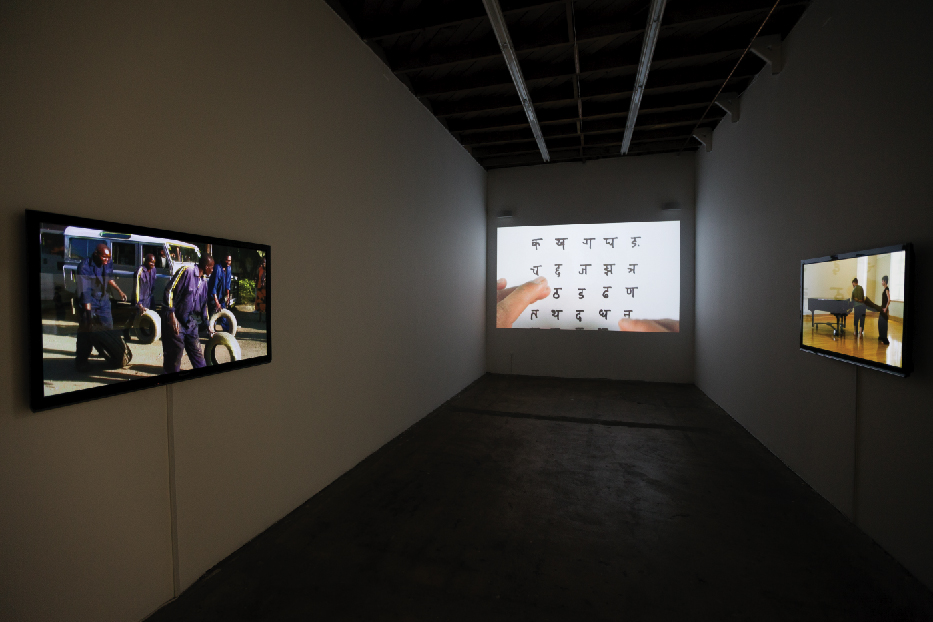Creating a video of people playing a piano with another person’s head is a far cry from UCLA alumnus Tejpal Ajji’s original intention of becoming an ancient Greek art historian. When he was a second-year undergraduate student at the University of Toronto, Ajji started making videos in a sculpture class and got hooked on video making.
“Unlike sculpture, where you had to model or do any number of technical things, if I just turned the camera on, the work was already started and I could do something in front of it,” Ajji said.
Since receiving his master of fine arts degree from the UCLA art department in the spring of 2012, Ajji has been working on his latest exhibition, titled “Direction Pieces,” which is currently on display at the independent, nonprofit LA > < ART gallery on La Cienega Boulevard. Heber Rodriguez, associate curator for LA > < ART, said that the space focuses on showcasing artwork produced directly by artists who have free reign over the two empty gallery rooms. This exhibition is also Ajji’s first major endeavor since finishing graduate school and includes three action-based videos directed by the artist.
Ajji said “Direction Pieces” combines performance and ethnography and focuses on unexpected encounters, such as individuals performing strange or unconventional actions. The exhibition consists of three videos that are constantly playing as visitors enter Ajji’s portion of the gallery. Ajji said this is the type of visual and performance art that he has been working on most recently.
“The videos are often performances or scenarios where I give people a set of directions and those get played out over time,” Ajji said. “One of the directions was four performers, and everyone’s in a dance studio. Three performers lift up the fourth performer and they carry this person until they reach a grand piano, and then they use the fourth performer’s head to play the piano.”
Ajji said that while the process of coming up with ideas for these videos is often unpredictable and difficult to describe, he is interested in a set of locations that are distinctive to his life or that he has visited. The piano video, for example, was filmed in a dance studio at UCLA. Ajji said he then tries to come up with a direction that focuses on interpersonal relationships within that location.
In each of the videos in the exhibition, Ajji said the performers are a combination of people that he knows as well as strangers or people that he has just met. He comes up with a situation for them to act out and gives them directions that represent an encounter between a group of people.
“In one piece, there are four men and each have a tire in their hand and they roll out of a car auto body shop almost as if they’re a car and they roll down the street,” Ajji said. “I didn’t personally know all of the men, but I was familiar with them. They’re a part of my life in some way.”
Ajji also said that he did not ask performers to change their clothes and prefers to have them wear the costume of everyday life in order to mirror the fact that these encounters occur in common spaces among people who may or may not know each other.
Within the exhibition, there is one large projection with a video called “Hindi” in which Ajji turns the alphabet into a kind of piano by assigning a sound to each letter. To the right and left there are two large video monitors that display the piano piece and video of the men rolling out of the auto shop.
“There are no headphones, so all of the sound is heard together. You’ll hear all of these different locations come together in that room ““ my voice, the piano and the street,” Ajji said.
Ajji also said that he has chosen to pursue this type of art because it is what best represents the message that he wants to convey. He said that in many of his videos he takes the idea of encounters between different people and flips it on its head in order to provide an alternative perspective.
“I’m not trying to make a film and I’m not trying to make a theater piece. I’m trying to make a piece that really works against a lot of those conventions ““ narrative, story, character, plot development. It’s something that’s a little closer to everyday life tried differently,” Ajji said.
Amanda Hunt, curator at LA > < ART, said that visitors to the exhibition have been curious about where the videos were filmed and where people tend to spend time in the space.
“It’s been a very successful show,” Hunt said. “We’ve had a lot of visitors and people who have returned and we’ve seen the UCLA community be very supportive.”
To mark the close of the exhibition Saturday evening, Ajji will have his first live gallery performance, accompanied by five other people who will be playing Indian and Pakistani concert instruments. This live performance will be an opportunity for viewers to experience a performance that is similar to those acted out in Ajji’s videos.
As he moves forward in his career as an artist, Ajji said that he would like to get a teaching job at a university and work with students and colleagues on future projects.
“I really just love having the opportunity to continue making art, and to do it in a very conscious way,” Ajji said.
